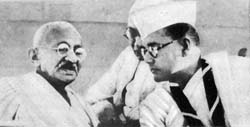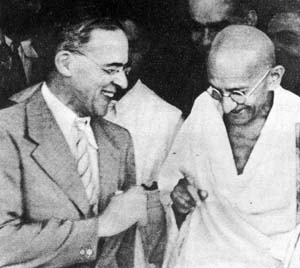
P.O. SEVAGRAM, DIST.WARDHA 442102, MS, INDIA. Phone: 91-7152-284753
FOUNDED BY MAHATMA GANDHI IN 1936
The Story of Gandhi

THE STORY OF GANDHI
Written by : Rajkumari Shanker
Table of Contents
- Birth And Childhood
- Preparation for England
- In England
- Back In India
- In South Africa
- In India
- Back In South Africa
- Indian National Congress
- In South Africa Again
- Assault
- Tolstoy Farm
- Returned To India
- Establishment of Satyagraha Ashram
- Benaras Speech
- Champaran Satyagraha
- Ahmedabad Mill-Workers Satyagraha
- Rowlatt Act
- Jallianwalla Bagh Massacre
- In Prison
- Salt Satyagraha
- Sevagram
- Cabinet Mission Plan
- Quit India
- He Ram!!!
About This Book
Written by : Rajkumari Shanker
First Edition :1969
I.S.B.N :81-7011-064-5
Published by :Children's Book Trust,
Nehru House, 4
Bahadur Shah Zafar Marg,
New Delhi 110 002,
India.
© CBT, 1969
Download
Chapter-22: Cabinet Mission Plan
In 1939 the Second World War broke out. England and France declared war on Nazi Germany. Without consulting Indian leaders, Britain declared India to be at war on the allies' side.
Gandhi's sympathies were with the British, but the believed that all violence was evil and he would therefore have nothing to do with the war effort, although he gave England his moral support.
The Indian National Congress wanted to help Britain and fight on the allies' side, but only as a free nation. But to grant India independence seemed ridiculous to Churchill and his Government. They had no intention the co-operation offered by the Congress.
As a protest, all the Congress ministries in the provinces resigned. The Government took over the administration and they acted in such a way as to help their war effort. Acting on the goodwill and restraint taught by Gandhi, the Indian leaders showed no reaction.
Events in Europe were having repercussions in India however. The Congress working Committee found itself unable to accept in its entirety Gandhi's attitude to the war. In particular they would not accept his view that the defence of India should not depend on armed force.
The leaders met again and again in Gandhi's room at Sevagram and talked of their desire to start some action. Finally a proposal was put forward that all provincial Governments should join with the British authorities in the defence of India. The Government, however, rejected the offer.
In September 1940, a meeting of All-India Congress Committee was held in Bombay. There as a protest against England's utter indifference to India's hopes, it was decided to launch individual civil disobedience against the authorities. It was also decided to hold meetings to protest against British imperialism. At that time such meetings were forbidden.
Vinoba Bhave was the first to inaugurate individual satyagraha. He was arrested and so were hundreds of other who followed him.
Nehru also was arrested. Within a few months over thirty thousand Congressmen were put in jail.
Gandhi alone was not imprisoned. He devoted his time to spreading the gospel of truth and non-violence. In December 1941 the Government released all the satyagrahis. Then, in 1942, as the Japanese swept across the Pacific and went through Malaya and Burma, the British began to think of a settlement with India. Japan might even invade India.
With the threat of invasion by Japan even Gandhi began to feel that his pacifism might stand in the way of India's future. So he made the proposal of a provisional Government's side in the struggle against the aggressors. But this proposal was ignored.
In March 1942 Churchill announced that the war cabinet had agreed on a plan for India and that Sir Stafford Cripps had agreed to go to India to find out whether the Indian leaders would accept the plan, and whether they would devote all their thought and energy to the defence of India against Japan.
Sir Stafford Cripps arrived in Delhi on March-22. He met Gandhi, Nehru, Azad, Jinnah and other important leaders. Cripps promised greater freedom than that which had been offered before. He also offered complete freedom after the war, if India wanted it. The leaders would perhaps have accepted this offer if it had come a year earlier, but now it was rejected.
The Congress leaders did not trust the people of India sufficiently to give them any real power, and so the Indian leaders felt that they could not trust the British to hand over power after the war.


Figure 1: With Subhash Chandra Bose, 1938
Figure 2: With Tagore at Santiniketan, 1946.
Figure 3: With Sir Stafford Cripps, 1942.